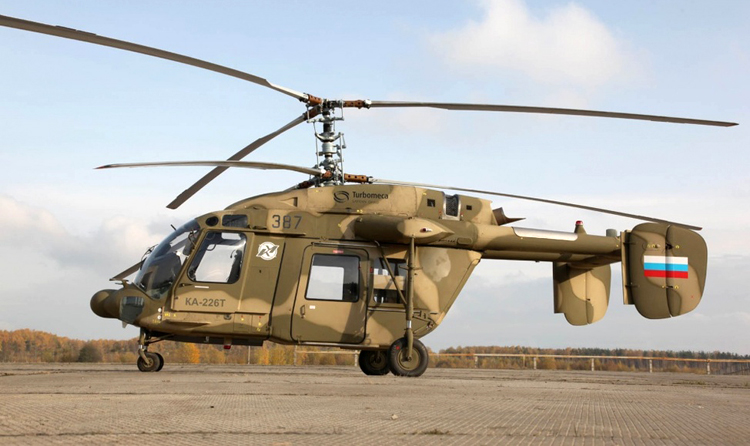INDIAN ARMED FORCES CHIEFS ON OUR RELENTLESS AND FOCUSED PUBLISHING EFFORTS

SP Guide Publications puts forth a well compiled articulation of issues, pursuits and accomplishments of the Indian Army, over the years

"Over the past 60 years, the growth of SP Guide Publications has mirrored the rising stature of Indian Navy. Its well-researched and informative magazines on Defence and Aerospace sector have served to shape an educated opinion of our military personnel, policy makers and the public alike. I wish SP's Publication team continued success, fair winds and following seas in all future endeavour!"

Since, its inception in 1964, SP Guide Publications has consistently demonstrated commitment to high-quality journalism in the aerospace and defence sectors, earning a well-deserved reputation as Asia's largest media house in this domain. I wish SP Guide Publications continued success in its pursuit of excellence.
Kamov helicopters — Finally through?
 |
By Lt. General P.C. Katoch (Retd) Former Director General of Information Systems, Indian Army |

In March 2017, media reported that the Indo-Russian Kamov helicopter deal had hit a hurdle, pricing and technology transfer being main issues. The news said that India and Russia were having a disagreement over the joint production of Kamov-226T light-utility helicopter that was announced as the first major 'Make in India' project some five months ago. Another reason quoted was that Russia was yet to give approval for the project while related technology transfers 'through a private Indian partner' were the two stumbling blocks. It may be recalled that in December 2015 it was announced that Kamov-226T will be copter of choice for Make in India, India and Russia having inked the inter-governmental agreement for the light utility helicopter. During the meeting between PM Narendra Modi and President Putin at Goa in 2016, the shareholders pact for the joint venture to manufacture the Ka-226T helicopters in India was signed; a private partner was part of this inter-government agreement.
Russia already had Hindustan Aeronautics Limited (HAL) as the Indian partner, but the MoD is looking to have private sector Indian investors to share a part of the contract that India has to execute under a joint venture with Moscow. So while price negotiations are a done thing, the delay in nominating the private Indian company other than the HAL is attributable to India, not Russia. In fact, when NSA Ajit Doval visited Russia in January 2017, Russian authorities asked him reasons why the Kamov helicopter deal was being delayed by the Indian side. The transfer of technology (ToT) would hardly have been a problem, the Kamov being quite different from the BrahMos supersonic missile. But possibly the name(s) of private partners were not intimated to Russia then. Whatever be the case, the good news is that President Putin has given the final go-ahead for the joint venture. It may be recalled that the armed forces endeavour to procure 197 such last utility helicopters been scrapped three times over the last decade due to corruption allegations and technical deviations, which has created criticality of helicopter holdings in this category. The three services and the Coast Guard currently have 430 Cheetah/Chetaks helicopters. They are based on the 1950s' designed Alouette Aérospatiale 315B Lama of France. Post series of helicopter crashes and loss of precious lives, Manohar Parrikar when Defence Minister was petitioned by a group of wives of Army officers to stop the use of the "outdated and ageing" Cheetah and Chetak helicopters, which are without modern avionics but are even flown to service forward areas like the Siachen Glacier-Saltoro Ridge region.
The armed forces urgently need 484 light choppers to replace their obsolete single-engine Cheetah/Chetak fleets, which have been dogged by a high crash rate and serviceability problems. Overall some 800 helicopters over the next decade are required by Indian security forces which is beyond the capability of HAL The twin-engine Kamov 226T will replace the single-engine Cheetah/Chetak, usually deployed for surveillance, dropping small loads and for rescue, including of troops posted at forbidding heights such as the Siachen Glacier-Saltoro Ridge region. The twin-engine Kamov-226Ts are multi-role helicopters, which can undertake reconnaissance, patrol and disaster relief operations as well as transport eight combat-ready soldiers with a maximum range of 600 km. However, the project is not getting off tomorrow, as may be perceived by some.
MoD will now ask the private company/companies (HAL being the lead integrator for the project) to submit its technical and commercial proposal within six months, meaning some cost negotiation will be carried out in the future as well. Nomination of this company too may see some turbulence because the chapter on 'strategic partnership' in the DPP 2016 is still to be scripted. Kamov-HAL are to produce 200 of the Kamov 226T copters at a cost of nearly US$ 1 billion (6,500 crore) or 32 crore per copter. Sixty of these copters will come in fly-away condition from Russia, another 40 will be assembled in India and the remaining 100 will be fully built in India. India will have 50.5 per cent stake in the joint venture, of which the private sector companies will be strategic partners with HAL. The private partners would assist in the joint venture at HAL's Bangalore facility. The Indo-Russia joint venture aims to have an annual production capacity of 40-60 helicopters. Under the agreement, the Kamov engine will involve a separate partnership. Kamov uses French engine-maker Turbomeca's power plant. The HAL already has a partnership with the same French company to produce engines for its indigenously developed 'Dhruv' helicopter The Kamov 226T is also fitted with Turbomeca engines, but a different variant.





